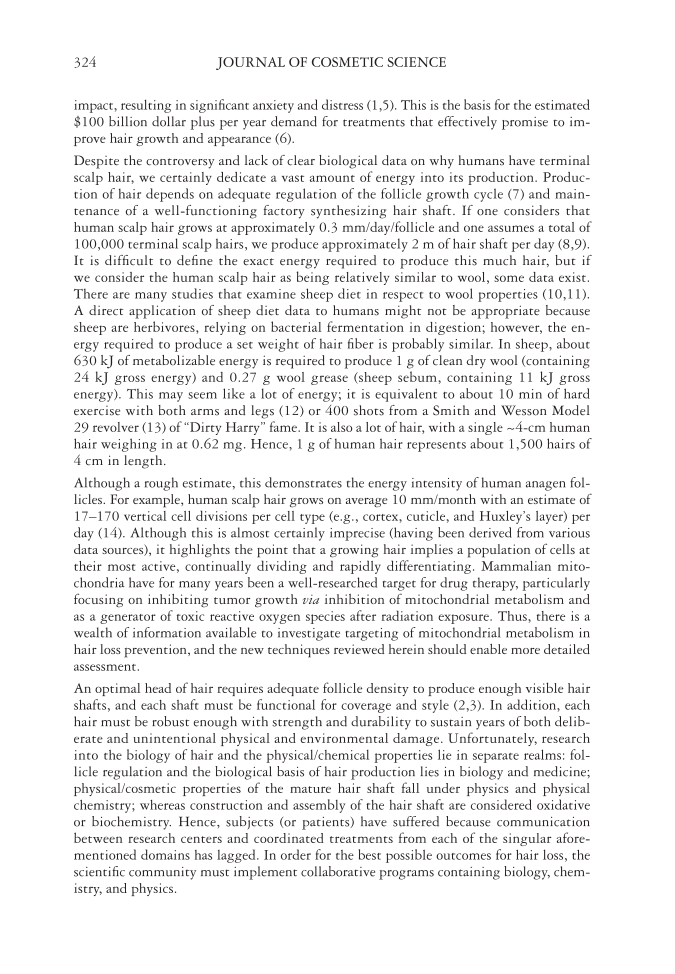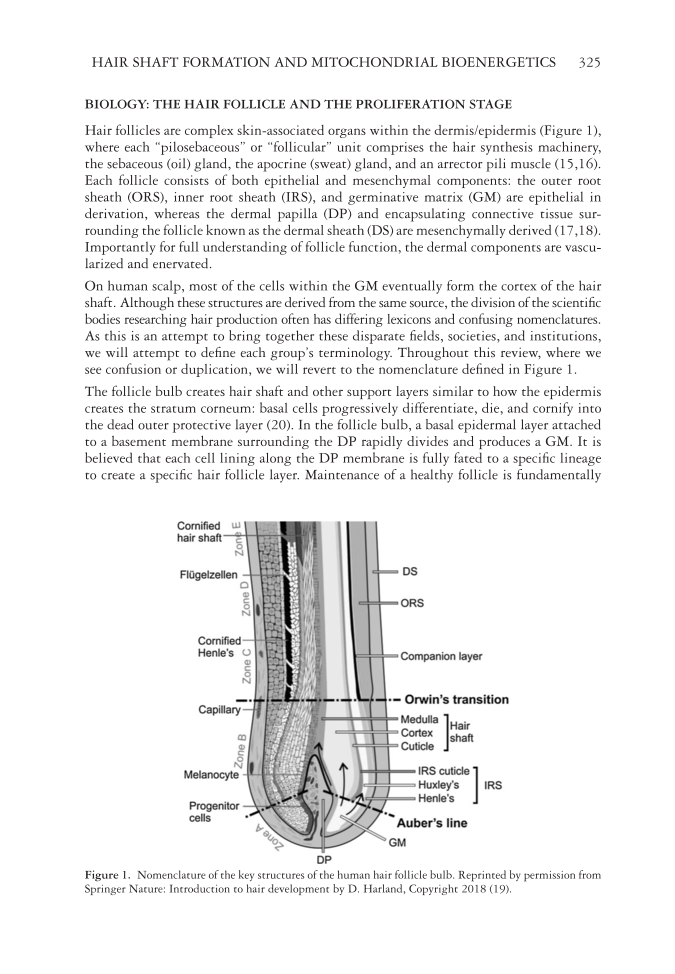JOURNAL OF COSMETIC SCIENCE 324 impact, resulting in signifi cant anxiety and distress (1,5). This is the basis for the estimated $100 billion dollar plus per year demand for treatments that effectively promise to im- prove hair growth and appearance (6). Despite the controversy and lack of clear biological data on why humans have terminal scalp hair, we certainly dedicate a vast amount of energy into its production. Produc- tion of hair depends on adequate regulation of the follicle growth cycle (7) and main- tenance of a well-functioning factory synthesizing hair shaft. If one considers that human scalp hair grows at approximately 0.3 mm/day/follicle and one assumes a total of 100,000 terminal scalp hairs, we produce approximately 2 m of hair shaft per day (8,9). It is diffi cult to defi ne the exact energy required to produce this much hair, but if we consider the human scalp hair as being relatively similar to wool, some data exist. There are many studies that examine sheep diet in respect to wool properties (10,11). A direct application of sheep diet data to humans might not be appropriate because sheep are herbivores, relying on bacterial fermentation in digestion however, the en- ergy required to produce a set weight of hair fi ber is probably similar. In sheep, about 630 kJ of metabolizable energy is required to produce 1 g of clean dry wool (containing 24 kJ gross energy) and 0.27 g wool grease (sheep sebum, containing 11 kJ gross energy). This may seem like a lot of energy it is equivalent to about 10 min of hard exercise with both arms and legs (12) or 400 shots from a Smith and Wesson Model 29 revolver (13) of “Dirty Harry” fame. It is also a lot of hair, with a single ~4-cm human hair weighing in at 0.62 mg. Hence, 1 g of human hair represents about 1,500 hairs of 4 cm in length. Although a rough estimate, this demonstrates the energy intensity of human anagen fol- licles. For example, human scalp hair grows on average 10 mm/month with an estimate of 17–170 vertical cell divisions per cell type (e.g., cortex, cuticle, and Huxley’s layer) per day (14). Although this is almost certainly imprecise (having been derived from various data sources), it highlights the point that a growing hair implies a population of cells at their most active, continually dividing and rapidly differentiating. Mammalian mito- chondria have for many years been a well-researched target for drug therapy, particularly focusing on inhibiting tumor growth via inhibition of mitochondrial metabolism and as a generator of toxic reactive oxygen species after radiation exposure. Thus, there is a wealth of information available to investigate targeting of mitochondrial metabolism in hair loss prevention, and the new techniques reviewed herein should enable more detailed assessment. An optimal head of hair requires adequate follicle density to produce enough visible hair shafts, and each shaft must be functional for coverage and style (2,3). In addition, each hair must be robust enough with strength and durability to sustain years of both delib- erate and unintentional physical and environmental damage. Unfortunately, research into the biology of hair and the physical/chemical properties lie in separate realms: fol- licle regulation and the biological basis of hair production lies in biology and medicine physical/cosmetic properties of the mature hair shaft fall under physics and physical chemistry whereas construction and assembly of the hair shaft are considered oxidative or biochemistry. Hence, subjects (or patients) have suffered because communication between research centers and coordinated treatments from each of the singular afore- mentioned domains has lagged. In order for the best possible outcomes for hair loss, the scientifi c community must implement collaborative programs containing biology, chem- istry, and physics.
HAIR SHAFT FORMATION AND MITOCHONDRIAL BIOENERGETICS 325 BIOLOGY: THE HAIR FOLLICLE AND THE PROLIFERATION STAGE Hair follicles are complex skin-associated organs within the dermis/epidermis (Figure 1), where each “pilosebaceous” or “follicular” unit comprises the hair synthesis machinery, the sebaceous (oil) gland, the apocrine (sweat) gland, and an arrector pili muscle (15,16). Each follicle consists of both epithelial and mesenchymal components: the outer root sheath (ORS), inner root sheath (IRS), and germinative matrix (GM) are epithelial in derivation, whereas the dermal papilla (DP) and encapsulating connective tissue sur- rounding the follicle known as the dermal sheath (DS) are mesenchymally derived (17,18). Importantly for full understanding of follicle function, the dermal components are vascu- larized and enervated. On human scalp, most of the cells within the GM eventually form the cortex of the hair shaft. Although these structures are derived from the same source, the division of the scientifi c bodies researching hair production often has differing lexicons and confusing nomenclatures. As this is an attempt to bring together these disparate fi elds, societies, and institutions, we will attempt to defi ne each group’s terminology. Throughout this review, where we see confusion or duplication, we will revert to the nomenclature defi ned in Figure 1. The follicle bulb creates hair shaft and other support layers similar to how the epidermis creates the stratum corneum: basal cells progressively differentiate, die, and cornify into the dead outer protective layer (20). In the follicle bulb, a basal epidermal layer attached to a basement membrane surrounding the DP rapidly divides and produces a GM. It is believed that each cell lining along the DP membrane is fully fated to a specifi c lineage to create a specifi c hair follicle layer. Maintenance of a healthy follicle is fundamentally Figure 1 . Nomenclature of the key structures of the human hair follicle bulb. Reprinted by permission from Springer Nature: Introduction to hair development by D. Harland, Copyright 2018 (19).
Purchased for the exclusive use of nofirst nolast (unknown) From: SCC Media Library & Resource Center (library.scconline.org)









































































































